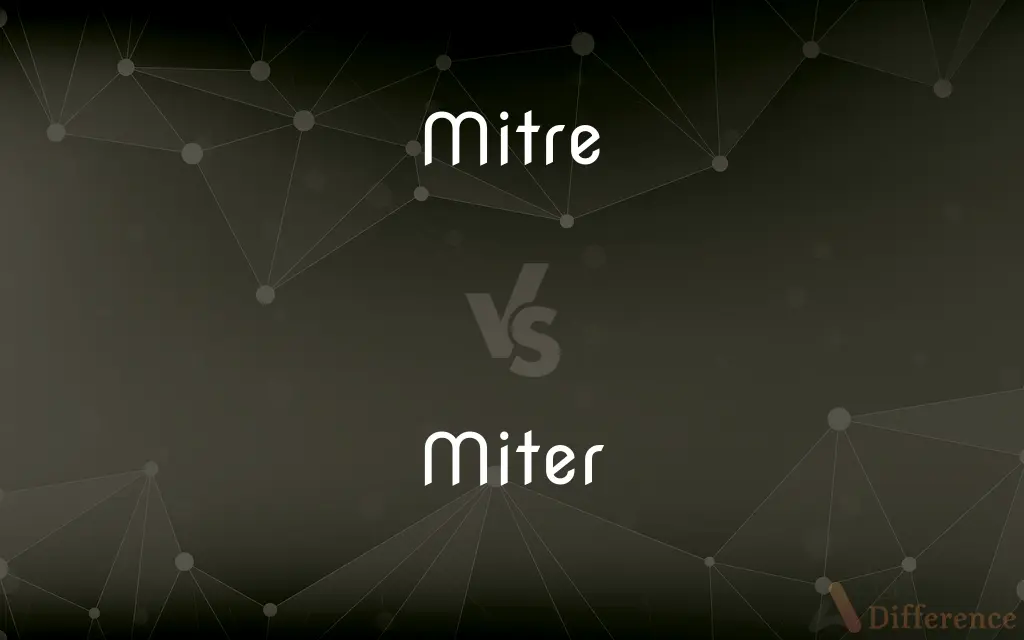Mitre vs. Miter — What's the Difference?
By Fiza Rafique & Maham Liaqat — Updated on April 7, 2024
Mitre and miter are variations in spelling of the same term, referring to an angled joint or cut, with "mitre" being the British English version and "miter" the American English version.

Difference Between Mitre and Miter
Table of Contents
ADVERTISEMENT
Key Differences
The terms mitre and miter refer to the same concept in woodworking and construction, which is an angled interface between two pieces, typically at a 45-degree angle to form a 90-degree corner. The difference in spelling reflects the linguistic distinctions between British and American English, with "mitre" being preferred in the UK and Commonwealth countries, whereas "miter" is used in the United States.
In addition to construction and woodworking, the spelling variation also applies to the ceremonial headgear worn by bishops and certain abbots in Christianity, known as a mitre in British English and a miter in American English. This headgear features two pointed peaks and is symbolic of ecclesiastical authority and status.
The choice between mitre and miter does not imply a difference in meaning or function but is purely a matter of regional spelling preference. Therefore, when referring to the tool used to make such cuts, a "mitre saw" in the UK becomes a "miter saw" in the US, though the tool functions identically in both contexts.
Despite the spelling differences, in practical and professional settings, the understanding of mitre/miter is consistent across English-speaking countries. This uniformity ensures that professionals in construction, woodworking, and religious contexts can communicate effectively regardless of the regional spelling variations.
Comparison Chart
Spelling
British English
American English
ADVERTISEMENT
Usage
Woodworking, construction, ecclesiastical attire
Woodworking, construction, ecclesiastical attire
Example Context
"The carpenter made a precise mitre cut."
"The carpenter made a precise miter cut."
Tool Name
Mitre saw
Miter saw
Ecclesiastical Hat
Worn by bishops, known as a mitre in the UK
Known as a miter in the US
Compare with Definitions
Mitre
Cut at a 45-degree angle.
He measured carefully before making the mitre cut.
Miter
Cut to form a corner.
The miter cut was perfectly aligned for the frame.
Mitre
Used in woodworking and construction.
Mitre joints are common in carpentry.
Miter
A bishop's ceremonial headgear.
The bishop's miter was adorned with jewels.
Mitre
A ceremonial headgear for bishops.
The bishop wore his mitre during the ceremony.
Miter
Reflected in tool terminology.
The miter saw made quick work of the cuts.
Mitre
An angled joint between two pieces.
The frame's corners were joined with a mitre.
Miter
An angled joint between two surfaces.
She checked the miter to ensure it was precise.
Mitre
Reflected in tool names.
He used a mitre saw for the woodwork.
Miter
Common in carpentry and construction.
Miter joints give a clean look to the project.
Mitre
The mitre (British English) (; Greek: μίτρα, "headband" or "turban") or miter (American English; see spelling differences), is a type of headgear now known as the traditional, ceremonial headdress of bishops and certain abbots in traditional Christianity. Mitres are worn in the Catholic Church, Orthodox Church, as well as in the Anglican Communion, some Lutheran churches, and also by bishops and certain other clergy in the Eastern Catholic Churches and the Oriental Orthodox Churches.
Miter
The liturgical headdress and part of the insignia of a Christian bishop. In the Western church it is a tall pointed hat with peaks in front and back, worn at all solemn functions.
Mitre
Variant of miter.
Miter
A thong for binding the hair, worn by women in ancient Greece.
Mitre
A covering for the head, worn on solemn occasions by church dignitaries, which has been made in many forms, mostly recently a tall cap with two points or peaks.
Miter
The ceremonial headdress worn by ancient Jewish high priests.
Mitre
The surface forming the bevelled end or edge of a piece where a miter joint is made; also, a joint formed or a junction effected by two beveled ends or edges; a miter joint.
Miter
A miter joint.
Mitre
A 13th-century coin minted in Europe which circulated in Ireland as a debased counterfeit sterling penny, outlawed under Edward I.
Miter
The edge of a piece of material that has been beveled preparatory to making a miter joint.
Mitre
A cap or cowl for a chimney or ventilation pipe.
Miter
A miter square.
Mitre
A gusset in sewing, etc.
Miter
To bestow a miter upon.
Mitre
A square with one triangular quarter missing from the outside.
Miter
To make (two pieces or surfaces) join with a miter joint.
Mitre
A mitre shell
Miter
To bevel the edges of for joining with a miter joint.
Mitre
To adorn with a mitre.
Miter
To meet in a miter joint.
Mitre
To unite at an angle of 45°.
Miter
(American spelling) to unite at an angle of 45°
Mitre
See Miter.
Miter
(American spelling) mitre
Mitre
Joint that forms a corner; usually both sides are bevelled at a 45-degree angle to form a 90-degree corner
Miter
A covering for the head, worn on solemn occasions by bishops and other church dignitaries. It has been made in many forms, the present form being a lofty cap with two points or peaks.
Mitre
The surface of a beveled end of a piece where a miter joint is made;
He covered the miter with glue before making the joint
Miter
The surface forming the beveled end or edge of a piece where a miter joint is made; also, a joint formed or a junction effected by two beveled ends or edges; a miter joint.
Mitre
A liturgical headdress worn by bishops on formal occasions
Miter
A sort of base money or coin.
Miter
To place a miter upon; to adorn with a miter.
Miter
To match together, as two pieces of molding or brass rule on a line bisecting the angle of junction; to fit together in a miter joint.
Miter
To bevel the ends or edges of, for the purpose of matching together at an angle.
Miter
To meet and match together, as two pieces of molding, on a line bisecting the angle of junction.
Miter
Joint that forms a corner; usually both sides are bevelled at a 45-degree angle to form a 90-degree corner
Miter
The surface of a beveled end of a piece where a miter joint is made;
He covered the miter with glue before making the joint
Miter
A liturgical headdress worn by bishops on formal occasions
Miter
Bevel the edges of, to make a miter joint
Miter
Confer a miter on (a bishop)
Miter
Fit together in a miter joint
Common Curiosities
Are mitre and miter the same?
Yes, they refer to the same concepts, differing only in regional spelling.
Do mitre and miter refer only to woodworking?
No, they also refer to a type of ecclesiastical headgear, in addition to their use in woodworking and construction.
What is a mitre/miter?
An angled joint or cut, typically at 45 degrees to form a 90-degree corner, or a ceremonial headgear for bishops.
Why are there two spellings, mitre and miter?
The variation reflects the difference between British and American English spelling preferences.
How do I know whether to use mitre or miter?
Your choice should be based on the version of English you are using or your regional spelling standards.
What tools are associated with making a mitre/miter cut?
A mitre saw (UK) or miter saw (US) is commonly used to make such cuts.
Can the terms be used interchangeably?
While they can be understood interchangeably, regional spelling norms are usually preferred.
Is there a difference in pronunciation between mitre and miter?
No, both terms are pronounced the same way.
Can mitre/miter joints be used in metalwork?
Yes, mitre/miter joints can also be applied in metalwork, not just in woodworking.
Is there a functional difference between joints called mitre and miter?
No, the functionality is identical, with the difference purely in spelling.
Share Your Discovery

Previous Comparison
Collaboration vs. Confrontation
Next Comparison
Bioremediation vs. PhytoremediationAuthor Spotlight
Written by
Fiza RafiqueFiza Rafique is a skilled content writer at AskDifference.com, where she meticulously refines and enhances written pieces. Drawing from her vast editorial expertise, Fiza ensures clarity, accuracy, and precision in every article. Passionate about language, she continually seeks to elevate the quality of content for readers worldwide.
Co-written by
Maham Liaqat















































